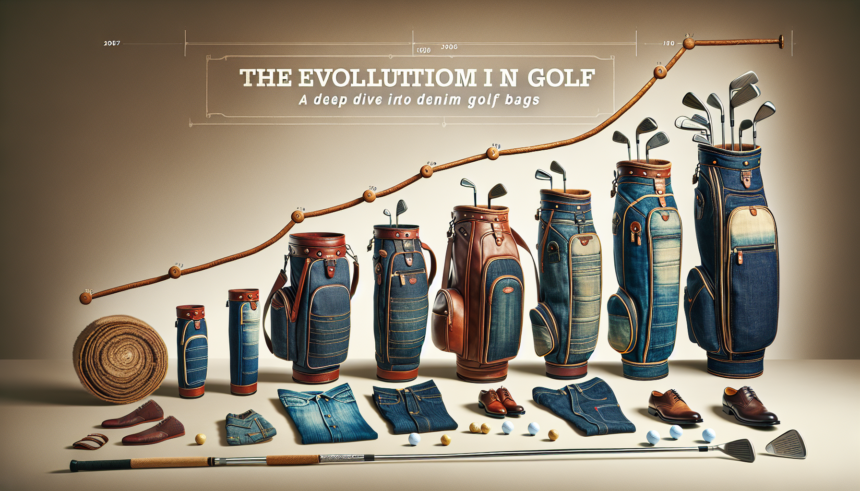The sport of golf, traditionally known for its strict dress codes and reliance on classic fabrics like cotton and wool, has recently witnessed a surprising twist: the introduction of denim. While denim has long been associated with casual wear and rugged durability, its entrance into the golf world has been both revolutionary and controversial. This article delves into the evolution of denim in golf, with a particular focus on denim golf bags, exploring the history, innovations, and future of this unexpected trend.
The Historical Context of Denim
Denim’s origins trace back to the late 19th century, most notably with Levi Strauss and Jacob Davis’s invention of riveted denim jeans in 1873. Originally designed for miners and laborers, denim became synonymous with durability and practicality. Over the decades, it grew into a fashion staple, beloved for its versatility and effortless style.
By the mid-20th century, denim had transcended its workwear roots to become a symbol of youth and rebellion, embraced by figures ranging from James Dean to modern-day fashion icons. But despite its wide-ranging appeal, denim remained largely absent from the world of sports—a domain where performance-driven fabrics typically reigned supreme.
Denim’s Entry into the World of Golf
Golf has long been a bastion of tradition, with its dress codes emphasizing conservative, often preppy attire. Yet as the sport aimed to attract a younger, more diverse audience in the 21st century, a slow but steady shift began to emerge. Golf apparel started to incorporate more casual and modern elements, leading to the curious introduction of denim.
Initially met with skepticism, denim’s move into golf was spearheaded by forward-thinking designers looking to challenge the status quo. It was not long before denim golf apparel, including jeans and skirts designed specifically for the golf course, gained traction. The most unexpected yet intriguing addition to this trend has been the denim golf bag.
Innovations in Denim Golf Bags
Denim golf bags combine the rugged, durable nature of traditional denim with modern, functional design elements. The use of high-quality denim, often blended with stretch or water-resistant materials, has allowed manufacturers to create bags that not only look stylish but also withstand the rigors of the golf course.
Key innovations in denim golf bags include:
- Lightweight Construction: Despite denim’s typically heavier weight, advances in fabric technology have enabled the production of lighter, more portable golf bags without compromising on durability.
- Weather Resistance: Some denim golf bags feature water-resistant coatings or are combined with waterproof fabrics, ensuring they remain practical in various weather conditions.
- Organizational Design: Modern denim golf bags come equipped with multiple pockets and compartments, providing ample space for clubs, balls, apparel, and personal items.
- Comfortable Carry Straps: Enhanced padding and ergonomic strap designs ensure that denim golf bags are comfortable to carry, even during long rounds of golf.
Market Reception and Popularity
The introduction of denim golf bags has been met with a mixed reception. Traditionalists argue that denim undermines the sport’s historic elegance, while progressive golfers champion the innovation as a fresh, stylish, and practical alternative to conventional materials.
Early adopters have praised denim golf bags for their unique aesthetic and durability. Social media influencers and professional golfers have played a significant role in promoting these bags, highlighting their advantages in various online platforms and golfing events. This exposure has helped to normalize the use of denim in golf, gradually shifting public perception.
The Future of Denim in Golf
The future of denim in golf looks promising, especially as the sport continues to evolve and attract new demographics. As fabric technology advances, we can expect further innovations in denim golf apparel and accessories. More eco-friendly production methods and sustainable materials are likely to be integrated, aligning with the growing trend toward environmental consciousness in fashion.
Manufacturers may also explore partnerships with renowned fashion brands to produce limited-edition denim golf collections, further cementing denim’s place in the world of golf. These collaborations could bridge the gap between traditional golf attire and contemporary trends, appealing to both seasoned players and newcomers alike.
Conclusion
The incorporation of denim into the golf world, culminating in the creation of denim golf bags, marks a revolutionary shift in the sport’s aesthetic and functional dynamics. While it challenges long-standing traditions, it also introduces a new era of style, practicality, and inclusivity. As the golfing community continues to embrace change, denim is poised to become an enduring element of golf culture, offering players a unique blend of classic durability and modern flair.
FAQs
1. Are denim golf bags as practical as traditional golf bags?
Yes, modern denim golf bags are designed to be just as practical, featuring lightweight construction, water-resistant coatings, and organized compartments to meet the needs of golfers.
2. Can I use a denim golf bag in any weather?
Many denim golf bags are made with water-resistant or weatherproof fabrics, making them suitable for diverse weather conditions. However, it is always advisable to check the product specifications.
3. Do denim golf bags come in different styles and sizes?
Yes, denim golf bags are available in various styles and sizes, from stand bags to cart bags, catering to different preferences and requirements.
4. How do I care for a denim golf bag?
Denim golf bags should be cared for according to the manufacturer’s instructions. Generally, wiping with a damp cloth and avoiding overexposure to harsh elements will help maintain the bag’s condition.
5. Are denim golf bags more expensive than traditional bags?
The price of denim golf bags can vary based on brand, design, and additional features. While some may be priced similarly to traditional bags, others, particularly designer collaborations, may be more expensive.






